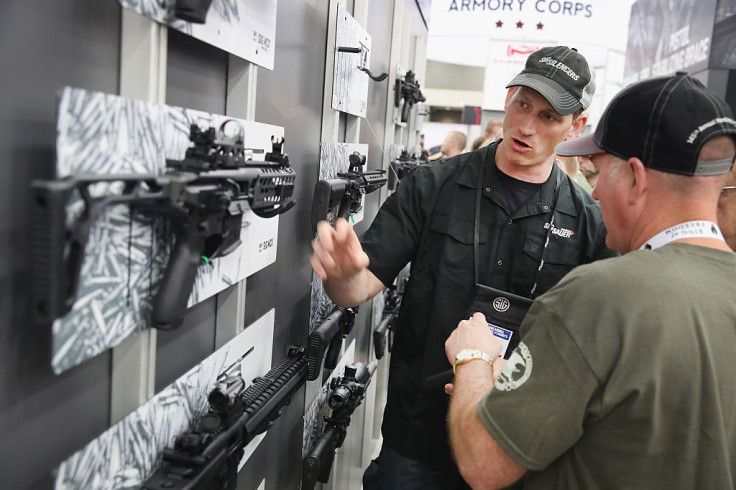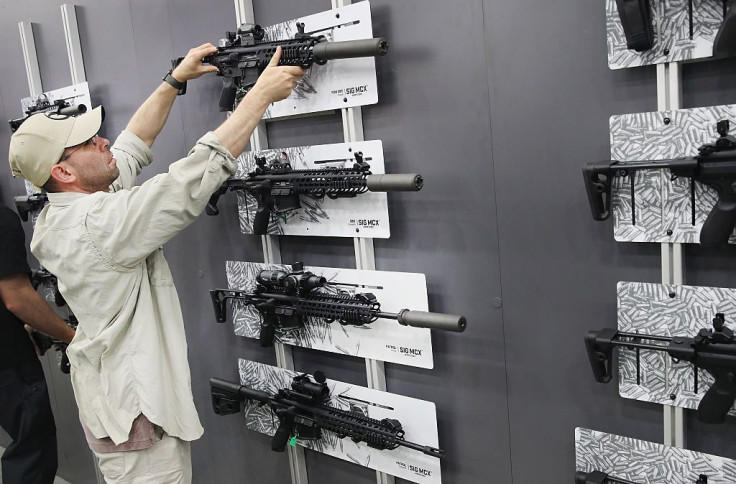Omar Mateen’s Gun: How Sig Sauer Cashed In By Selling Assault Rifles To Civilians

In 2004, Sig Sauer was on the brink of collapse. The New Hampshire weapons firm, which built the assault rifle used in the June 12 massacre in Orlando, Florida, was well known for high-quality handguns. But sales were flatlining. "It was a company on the verge of bankruptcy and about two seconds away from imploding," company CEO Ron Cohen recalled in a 2010 profile in Management Today.
Then, Cohen made a swift decision that would save the company and turn it into the No. 4 gun manufacturer in America: He turned the company’s sites onto "AR-style" assault rifles that would be marketed to civilians. A little more than a decade later, one of those assault rifles, a Sig Sauer MCX, was used by Omar Mateen to kill 49 people and injure dozens more at an LGBT nightclub in Orlando called Pulse.
That Mateen ended up with an assault rifle was no coincidence. The number of handgun owners in America had been in decline, but the expiration in 2004 of a decade-old federal assault weapons ban — which had been signed into law by President Bill Clinton — allowed U.S. gun manufacturers to start marketing AR-style assault rifles to civilians. Today, these types of weapons are the most profitable and desirable product line in the U.S. gun business.
Just as the U.S. auto industry discovered it could make huge margins on SUVs, the gun industry was able to create demand for a product that had few practical applications other than killing humans at scale.

Seizing an Opportunity
The pivot certainly worked for Sig Sauer. Cohen, once a commander in the Israeli army, seized on the opportunity to build high-end consumer assault rifles, which turned around the company.
In 2004 the company had a mere 130 employees. “At that point in time, the company just really didn’t have an offering of ARs,” said Jim Pledger, who served as the company’s vice president of law enforcement and military sales, 2002-2005. After Cohen’s arrival, Pledger said, the “company began to manufacture a line of very, very attractive rifles. Even though they were a little more expensive, they appealed to a lot of people.”
A decade later it sold 43,141 guns in a single year and today has more than 1,000 employees in manufacturing facilities across the country.
Sig Sauer was far from alone in this trend. In June 2006, Mike Golden, CEO of Smith & Wesson, told investors that “consumer response has been very strong” for the Massachusetts company's new AR, which has become the cash cow of the weapons industry. By 2014, the popular gun enthusiast magazine Task and Purpose wrote, “the AR-15 is perhaps the most ubiquitous firearm in American culture.”
The Sig Sauer MCX, which debuted in 2015, was met with particular acclaim. A military-style semi-automatic gun, the MCX has a sleek design — lightweight with a matte black finish. When it first came out, it was compared to Advanced Armament's Honey Badger PDW, another popular AR-style gun. But it became so popular that some gun aficionados dubbed it the “Black Mamba,” meaning “the snake that could kill the Honey Badger.”
The MCX was marketed extensively online with a highly produced YouTube series. The series features a gunman firing the MCX at various targets while traversing through a mock battlefield.

'A Pleasure to Fire'
The rifle drew raves from gun enthusiasts like Mike Searson from Ammoland.com for its design, modularity, and ease of use. “The SIG SAUER MCX rifle is truly the most modular black rifle ever designed by a firearms company and may unseat the venerable AR-15 as the most user-friendly rifle platform developed thus far,” he wrote. Nick Leghorn, a blogger on TheTruthAboutGuns.com, extols the MCX above all others. “The rifle just feels … right,” Leghorn writes. “Even with the can on the end, the gun balances well and is very easy to keep on target. The controls are crisp and clean, and the gun is really just a pleasure to fire.”
Shortly after Cohen’s arrival in 2004 he hired a new head of marketing, Bud Fini, to oversee the firm’s branding and marketing efforts. Pledger, the former Sig Sauer executive, credits Fini with knowing how to reposition the company’s brand for the consumer market.
“He really changed the marketing game for the company,” Pledger says. “He did an excellent job to help with better slogans, better mottos.” On its website, the company describes the MCX gun, which retails for under $2,000 to civilians, as "an innovative weapon system built around a battle-proven core."
A Sig Sauer representative did not return a request for comment from Fini or Cohen, but Fini talked about the success of his efforts with Guntalk Radio in a 2013 interview. “The last five to seven years have just been phenomenal for us,” he said, adding that the company doubled the size of its New Hampshire facilities in 2011, and then again in 2013. A main driver of that growth is from the rifle business, he said. “We wanted to change that perception so that we were a rifle company that makes handguns, and we are well on our way towards that,” he said.
The MCX helped propel Sig Sauer, a 150-year-old company with Swiss roots, from an also-ran in the U.S. gun industry to the fourth-largest rifle producer behind Ruger, Smith & Wesson and Remington according to Shooting Industry magazine.
'Cast All Restraint Aside'
To its critics, however, this is an alarming trend. The Violence Policy Center noted in a 2011 that the modern American gun industry "is a highly militarized and increasingly cynical industry that has cast all restraint aside to generate profit from military-style firearms.”
Unlike fully automatic weapons or machine guns, which are banned for civilian use, the Sig Sauer MCX can discharge only one bullet per trigger pull, which is why it’s classified as a “semi-automatic” weapon, and therefore legal for the U.S. market. While this feature is intended to make the weapon potentially less deadly, some gun experts argue it has the opposite effect because semiautomatic fire is more accurate than automatic fire.
Of course, the deadliness of the gun depends on who is holding it. Just last week, Democrats held a defiant sit-in in Congress to close the so-called “terror gap” that allows suspected terrorists to buy weapons. But despite the sit-in (as well as a 15-hour filibuster by U.S. Sen. Chris Murphy, D-Conn.), the U.S. Senate rejected four bills that sought to ban gun purchases by those on federal "no-fly" lists.
"I'm mortified by today's vote but I'm not surprised by it,” Murphy said. “The NRA has a vice-like grip on this place," he added, referring to the National Rifle Association, the pro-gun lobbying group.

Even President Barack Obama has been powerless to make any meaningful advances on gun control in his tenure. Interestingly, Obama has taken a keen focus on the type of weapons that are being used in so many mass shootings — the assault rifle. "Being tough on terrorism, particularly the sorts of homegrown terrorism that we've seen now in Orlando and San Bernardino [California], means making it harder for people who want to kill Americans to get their hands on assault weapons that are capable of killing dozens of innocents as quickly as possible,” Obama said last weekend.
So what comes next? Not much, in terms of legislative action. On July 5, the Democrats have pledged to make another run at forcing a vote on gun control. But for now, assault rifles will continue to drive the gun industry, unimpeded by regulation. Indeed, assault rifle sales tend to pick up after mass shootings as buyers worry it could become harder to buy one in the future.
“Greed, legislative cowardice, advanced technology — that is how we got here,” the Boston Globe editorial board wrote June 16. “The United States has been pummeled by gun violence since the assault weapons ban expired in 2004. This year, mass shootings have already claimed 61 lives. One class of gun, semiautomatic rifles, is largely responsible. But this nation cannot be a hostage of fear. We can make it stop.”
© Copyright IBTimes 2024. All rights reserved.




















